VOLVO V60 2014 Owners Manual
Manufacturer: VOLVO, Model Year: 2014, Model line: V60, Model: VOLVO V60 2014Pages: 442, PDF Size: 13.85 MB
Page 301 of 442
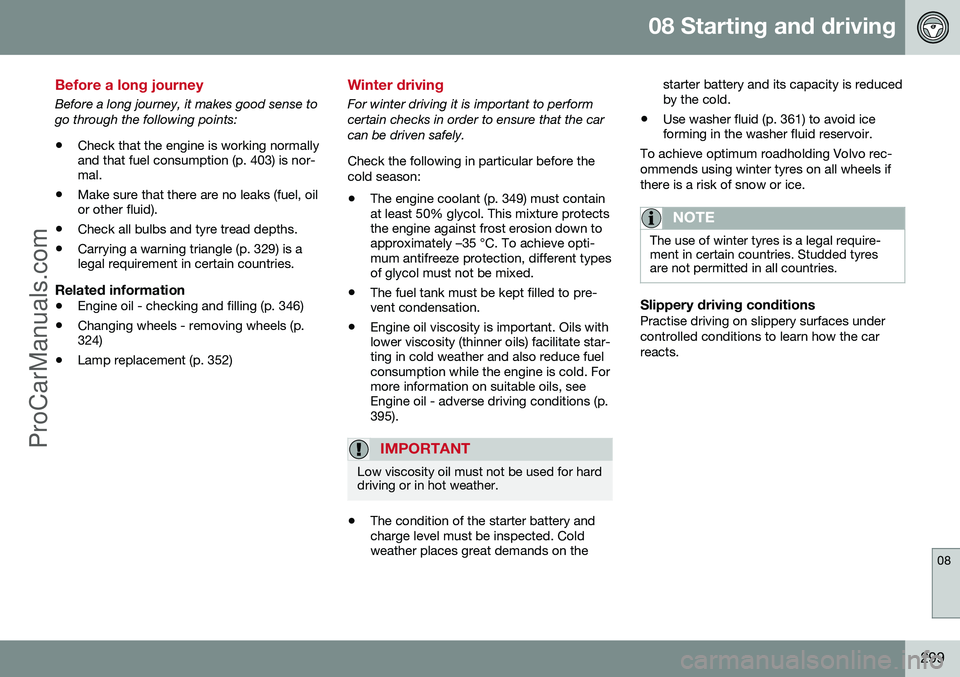
08 Starting and driving
08
299
Before a long journey
Before a long journey, it makes good sense to go through the following points: •Check that the engine is working normally and that fuel consumption (p. 403) is nor-mal.
• Make sure that there are no leaks (fuel, oilor other fluid).
• Check all bulbs and tyre tread depths.
• Carrying a warning triangle (p. 329) is alegal requirement in certain countries.
Related information
• Engine oil - checking and filling (p. 346)
• Changing wheels - removing wheels (p.324)
• Lamp replacement (p. 352)
Winter driving
For winter driving it is important to perform certain checks in order to ensure that the carcan be driven safely. Check the following in particular before the cold season:
• The engine coolant (p. 349) must contain at least 50% glycol. This mixture protectsthe engine against frost erosion down toapproximately –35 °C. To achieve opti-mum antifreeze protection, different typesof glycol must not be mixed.
• The fuel tank must be kept filled to pre-vent condensation.
• Engine oil viscosity is important. Oils withlower viscosity (thinner oils) facilitate star-ting in cold weather and also reduce fuelconsumption while the engine is cold. Formore information on suitable oils, seeEngine oil - adverse driving conditions (p.395).
IMPORTANT
Low viscosity oil must not be used for hard driving or in hot weather.
•The condition of the starter battery and charge level must be inspected. Coldweather places great demands on the starter battery and its capacity is reducedby the cold.
• Use washer fluid (p. 361) to avoid iceforming in the washer fluid reservoir.
To achieve optimum roadholding Volvo rec- ommends using winter tyres on all wheels ifthere is a risk of snow or ice.
NOTE
The use of winter tyres is a legal require- ment in certain countries. Studded tyresare not permitted in all countries.
Slippery driving conditionsPractise driving on slippery surfaces under controlled conditions to learn how the carreacts.
ProCarManuals.co’
Page 302 of 442
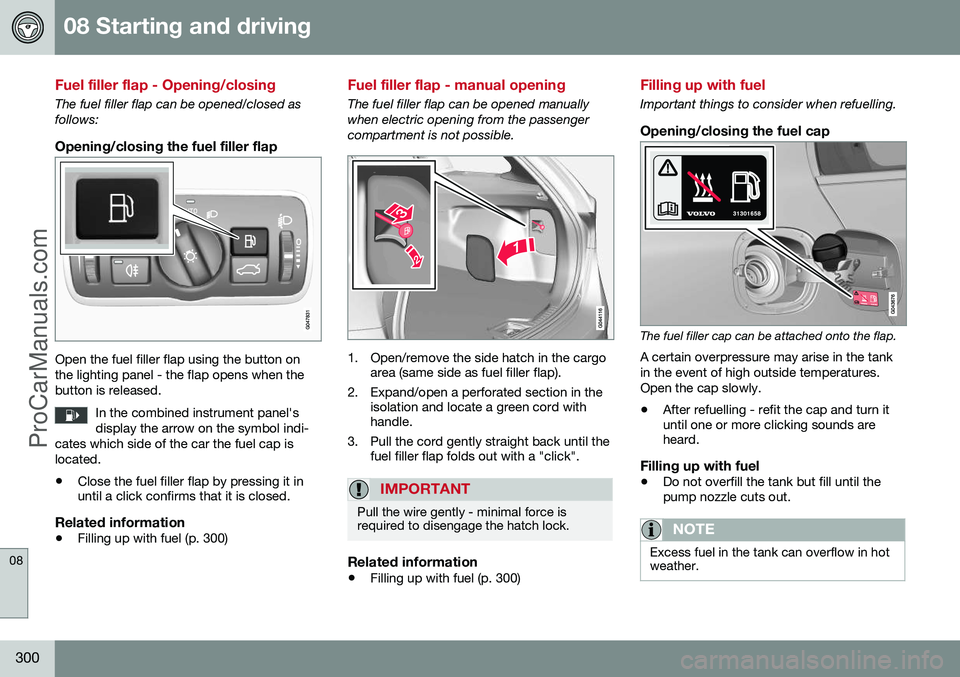
08 Starting and driving
08
300
Fuel filler flap - Opening/closing
The fuel filler flap can be opened/closed as follows:
Opening/closing the fuel filler flap
Open the fuel filler flap using the button on the lighting panel - the flap opens when thebutton is released.In the combined instrument panel'sdisplay the arrow on the symbol indi-
cates which side of the car the fuel cap islocated.
• Close the fuel filler flap by pressing it in until a click confirms that it is closed.
Related information
•Filling up with fuel (p. 300)
Fuel filler flap - manual opening
The fuel filler flap can be opened manually when electric opening from the passengercompartment is not possible.
1. Open/remove the side hatch in the cargo
area (same side as fuel filler flap).
2. Expand/open a perforated section in the isolation and locate a green cord with handle.
3. Pull the cord gently straight back until the fuel filler flap folds out with a "click".
IMPORTANT
Pull the wire gently - minimal force is required to disengage the hatch lock.
Related information
•Filling up with fuel (p. 300)
Filling up with fuel
Important things to consider when refuelling.
Opening/closing the fuel cap
The fuel filler cap can be attached onto the flap.
A certain overpressure may arise in the tank in the event of high outside temperatures.Open the cap slowly.
• After refuelling - refit the cap and turn it until one or more clicking sounds areheard.
Filling up with fuel
• Do not overfill the tank but fill until thepump nozzle cuts out.
NOTE
Excess fuel in the tank can overflow in hot weather.
ProCarManuals.co’
Page 303 of 442
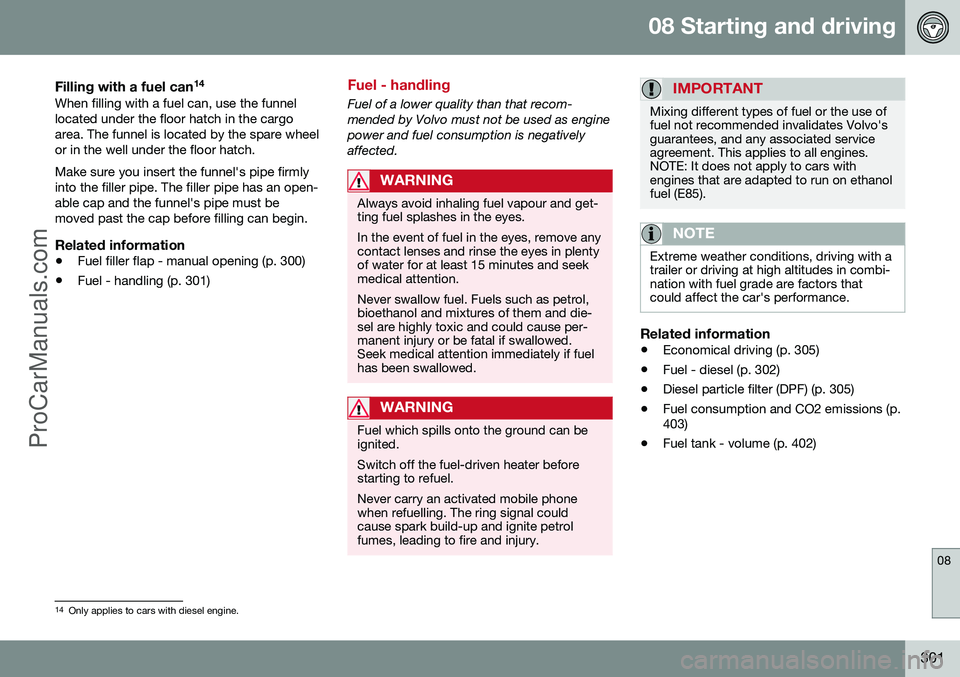
08 Starting and driving
08
301
Filling with a fuel can14When filling with a fuel can, use the funnel located under the floor hatch in the cargoarea. The funnel is located by the spare wheelor in the well under the floor hatch. Make sure you insert the funnel's pipe firmly into the filler pipe. The filler pipe has an open-able cap and the funnel's pipe must bemoved past the cap before filling can begin.
Related information
•
Fuel filler flap - manual opening (p. 300)
• Fuel - handling (p. 301)
Fuel - handling
Fuel of a lower quality than that recom- mended by Volvo must not be used as enginepower and fuel consumption is negativelyaffected.
WARNING
Always avoid inhaling fuel vapour and get- ting fuel splashes in the eyes. In the event of fuel in the eyes, remove any contact lenses and rinse the eyes in plentyof water for at least 15 minutes and seekmedical attention. Never swallow fuel. Fuels such as petrol, bioethanol and mixtures of them and die-sel are highly toxic and could cause per-manent injury or be fatal if swallowed.Seek medical attention immediately if fuelhas been swallowed.
WARNING
Fuel which spills onto the ground can be ignited. Switch off the fuel-driven heater before starting to refuel. Never carry an activated mobile phone when refuelling. The ring signal couldcause spark build-up and ignite petrolfumes, leading to fire and injury.
IMPORTANT
Mixing different types of fuel or the use of fuel not recommended invalidates Volvo'sguarantees, and any associated serviceagreement. This applies to all engines.NOTE: It does not apply to cars withengines that are adapted to run on ethanolfuel (E85).
NOTE
Extreme weather conditions, driving with a trailer or driving at high altitudes in combi-nation with fuel grade are factors thatcould affect the car's performance.
Related information
•Economical driving (p. 305)
• Fuel - diesel (p. 302)
• Diesel particle filter (DPF) (p. 305)
• Fuel consumption and CO2 emissions (p. 403)
• Fuel tank - volume (p. 402)
14
Only applies to cars with diesel engine.
ProCarManuals.co’
Page 304 of 442
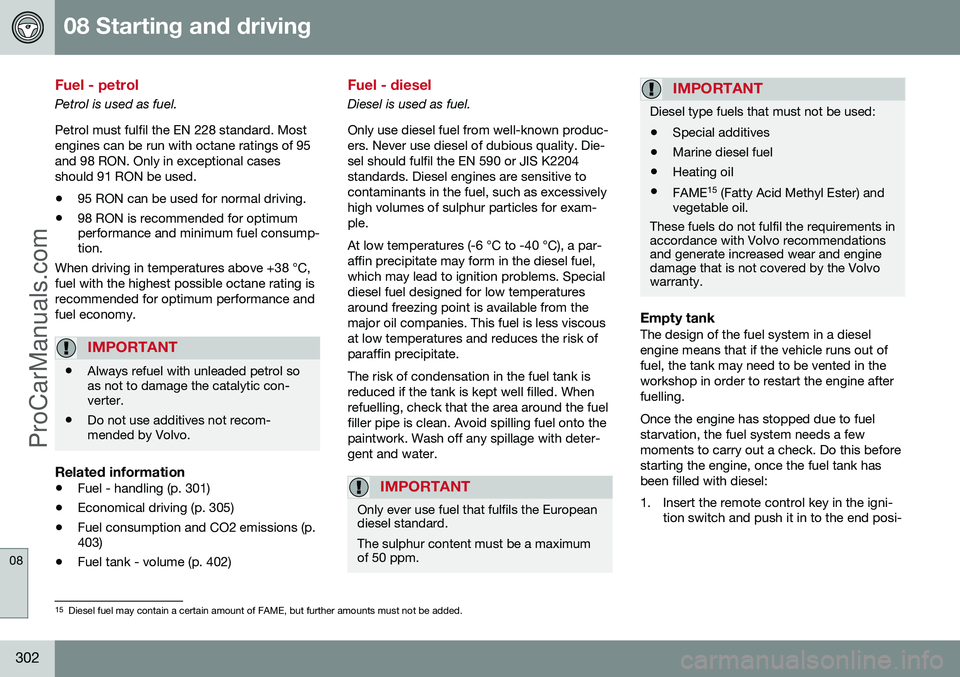
08 Starting and driving
08
302
Fuel - petrol
Petrol is used as fuel. Petrol must fulfil the EN 228 standard. Most engines can be run with octane ratings of 95and 98 RON. Only in exceptional casesshould 91 RON be used.
• 95 RON can be used for normal driving.
• 98 RON is recommended for optimum performance and minimum fuel consump-tion.
When driving in temperatures above +38 °C, fuel with the highest possible octane rating isrecommended for optimum performance andfuel economy.
IMPORTANT
• Always refuel with unleaded petrol so as not to damage the catalytic con-verter.
• Do not use additives not recom-mended by Volvo.
Related information
•
Fuel - handling (p. 301)
• Economical driving (p. 305)
• Fuel consumption and CO2 emissions (p. 403)
• Fuel tank - volume (p. 402)
Fuel - diesel
Diesel is used as fuel. Only use diesel fuel from well-known produc- ers. Never use diesel of dubious quality. Die-sel should fulfil the EN 590 or JIS K2204standards. Diesel engines are sensitive tocontaminants in the fuel, such as excessivelyhigh volumes of sulphur particles for exam-ple. At low temperatures (-6 °C to -40 °C), a par- affin precipitate may form in the diesel fuel,which may lead to ignition problems. Specialdiesel fuel designed for low temperaturesaround freezing point is available from themajor oil companies. This fuel is less viscousat low temperatures and reduces the risk ofparaffin precipitate. The risk of condensation in the fuel tank is reduced if the tank is kept well filled. Whenrefuelling, check that the area around the fuelfiller pipe is clean. Avoid spilling fuel onto thepaintwork. Wash off any spillage with deter-gent and water.
IMPORTANT
Only ever use fuel that fulfils the European diesel standard. The sulphur content must be a maximum of 50 ppm.
IMPORTANT
Diesel type fuels that must not be used:
• Special additives
• Marine diesel fuel
• Heating oil
• FAME 15
(Fatty Acid Methyl Ester) and
vegetable oil.
These fuels do not fulfil the requirements in accordance with Volvo recommendationsand generate increased wear and enginedamage that is not covered by the Volvowarranty.
Empty tankThe design of the fuel system in a diesel engine means that if the vehicle runs out offuel, the tank may need to be vented in theworkshop in order to restart the engine afterfuelling. Once the engine has stopped due to fuel starvation, the fuel system needs a fewmoments to carry out a check. Do this beforestarting the engine, once the fuel tank hasbeen filled with diesel:
1. Insert the remote control key in the igni- tion switch and push it in to the end posi-
15Diesel fuel may contain a certain amount of FAME, but further amounts must not be added.
ProCarManuals.co’
Page 305 of 442
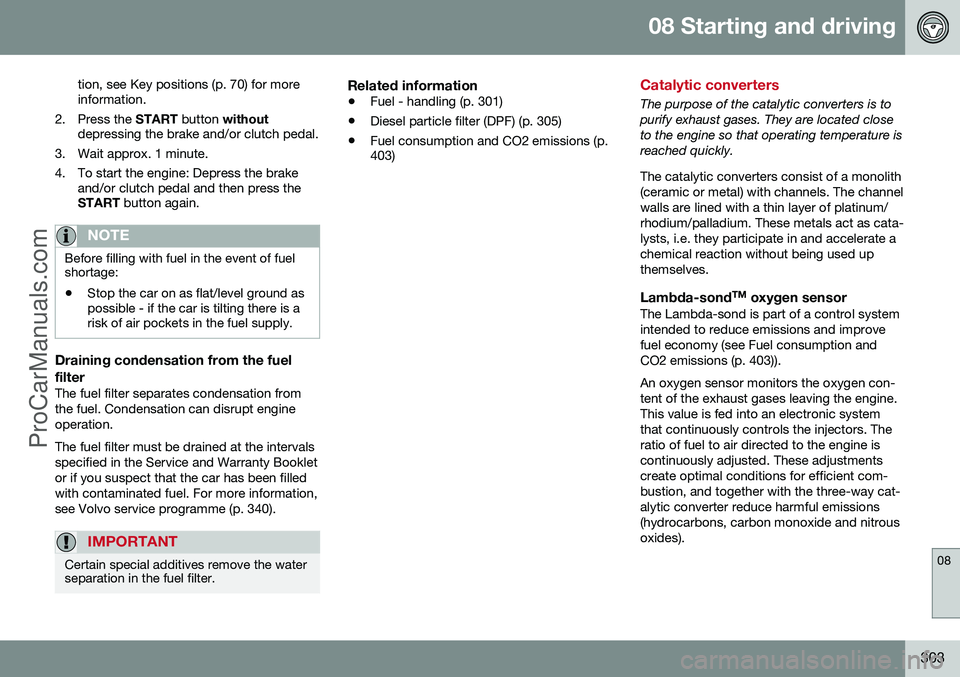
08 Starting and driving
08
303
tion, see Key positions (p. 70) for more information.
2. Press the START button without
depressing the brake and/or clutch pedal.
3. Wait approx. 1 minute.
4. To start the engine: Depress the brake and/or clutch pedal and then press the START button again.
NOTE
Before filling with fuel in the event of fuel shortage:
• Stop the car on as flat/level ground as possible - if the car is tilting there is arisk of air pockets in the fuel supply.
Draining condensation from the fuel filter
The fuel filter separates condensation from the fuel. Condensation can disrupt engineoperation. The fuel filter must be drained at the intervals specified in the Service and Warranty Bookletor if you suspect that the car has been filledwith contaminated fuel. For more information,see Volvo service programme (p. 340).
IMPORTANT
Certain special additives remove the water separation in the fuel filter.
Related information
•
Fuel - handling (p. 301)
• Diesel particle filter (DPF) (p. 305)
• Fuel consumption and CO2 emissions (p. 403)
Catalytic converters
The purpose of the catalytic converters is to purify exhaust gases. They are located closeto the engine so that operating temperature isreached quickly. The catalytic converters consist of a monolith (ceramic or metal) with channels. The channelwalls are lined with a thin layer of platinum/rhodium/palladium. These metals act as cata-lysts, i.e. they participate in and accelerate achemical reaction without being used upthemselves.
Lambda-sond TM
oxygen sensorThe Lambda-sond is part of a control systemintended to reduce emissions and improvefuel economy (see Fuel consumption andCO2 emissions (p. 403)). An oxygen sensor monitors the oxygen con- tent of the exhaust gases leaving the engine.This value is fed into an electronic systemthat continuously controls the injectors. Theratio of fuel to air directed to the engine iscontinuously adjusted. These adjustmentscreate optimal conditions for efficient com-bustion, and together with the three-way cat-alytic converter reduce harmful emissions(hydrocarbons, carbon monoxide and nitrousoxides).
ProCarManuals.co’
Page 306 of 442
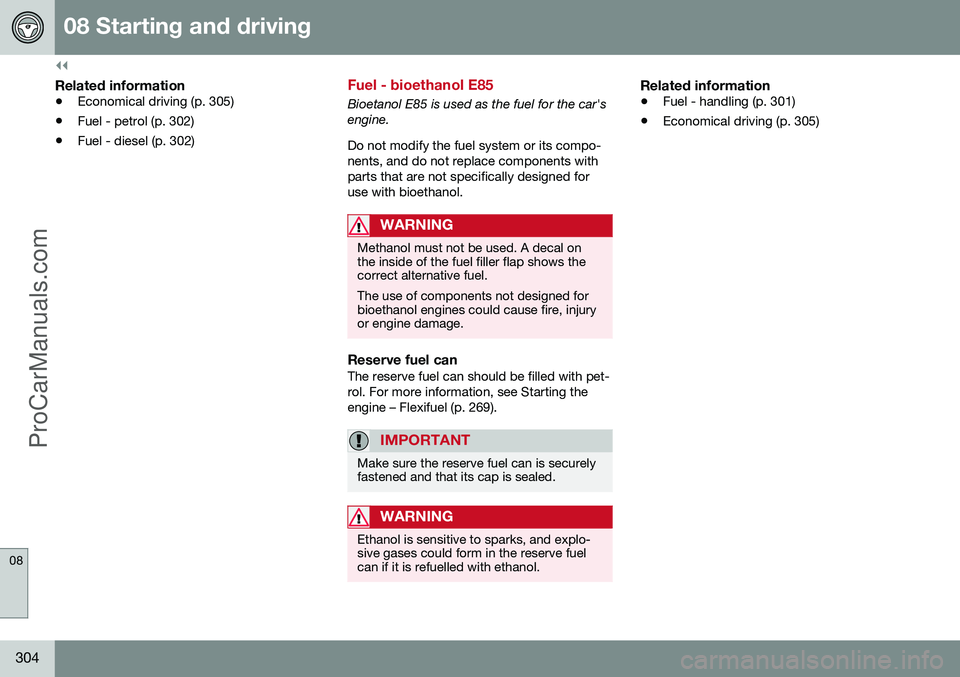
||
08 Starting and driving
08
304
Related information
•Economical driving (p. 305)
• Fuel - petrol (p. 302)
• Fuel - diesel (p. 302)
Fuel - bioethanol E85
Bioetanol E85 is used as the fuel for the car's engine. Do not modify the fuel system or its compo- nents, and do not replace components withparts that are not specifically designed foruse with bioethanol.
WARNING
Methanol must not be used. A decal on the inside of the fuel filler flap shows thecorrect alternative fuel. The use of components not designed for bioethanol engines could cause fire, injuryor engine damage.
Reserve fuel canThe reserve fuel can should be filled with pet- rol. For more information, see Starting theengine – Flexifuel (p. 269).
IMPORTANT
Make sure the reserve fuel can is securely fastened and that its cap is sealed.
WARNING
Ethanol is sensitive to sparks, and explo- sive gases could form in the reserve fuelcan if it is refuelled with ethanol.
Related information
• Fuel - handling (p. 301)
• Economical driving (p. 305)
ProCarManuals.co’
Page 307 of 442
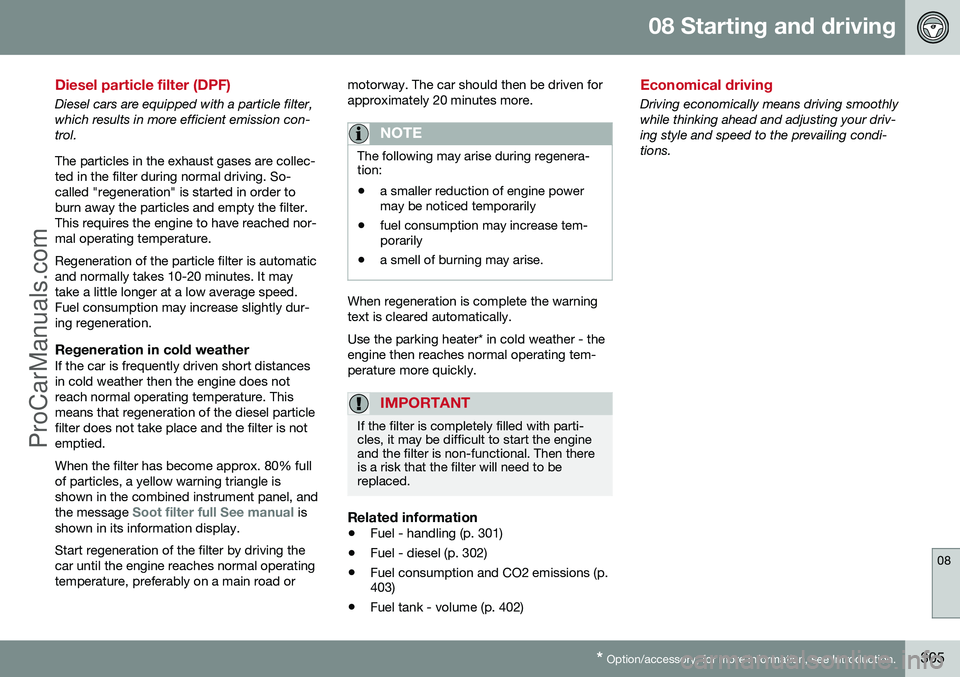
08 Starting and driving
08
* Option/accessory, for more information, see Introduction.305
Diesel particle filter (DPF)
Diesel cars are equipped with a particle filter, which results in more efficient emission con-trol. The particles in the exhaust gases are collec- ted in the filter during normal driving. So-called "regeneration" is started in order toburn away the particles and empty the filter.This requires the engine to have reached nor-mal operating temperature. Regeneration of the particle filter is automatic and normally takes 10-20 minutes. It maytake a little longer at a low average speed.Fuel consumption may increase slightly dur-ing regeneration.
Regeneration in cold weatherIf the car is frequently driven short distancesin cold weather then the engine does notreach normal operating temperature. Thismeans that regeneration of the diesel particlefilter does not take place and the filter is notemptied. When the filter has become approx. 80% full of particles, a yellow warning triangle isshown in the combined instrument panel, and the message
Soot filter full See manual is
shown in its information display. Start regeneration of the filter by driving the car until the engine reaches normal operatingtemperature, preferably on a main road or motorway. The car should then be driven forapproximately 20 minutes more.
NOTE
The following may arise during regenera- tion:
• a smaller reduction of engine power may be noticed temporarily
• fuel consumption may increase tem-porarily
• a smell of burning may arise.
When regeneration is complete the warning text is cleared automatically. Use the parking heater* in cold weather - the engine then reaches normal operating tem-perature more quickly.
IMPORTANT
If the filter is completely filled with parti- cles, it may be difficult to start the engineand the filter is non-functional. Then thereis a risk that the filter will need to bereplaced.
Related information
•
Fuel - handling (p. 301)
• Fuel - diesel (p. 302)
• Fuel consumption and CO2 emissions (p. 403)
• Fuel tank - volume (p. 402)
Economical driving
Driving economically means driving smoothly while thinking ahead and adjusting your driv-ing style and speed to the prevailing condi-tions.
ProCarManuals.com
Page 308 of 442
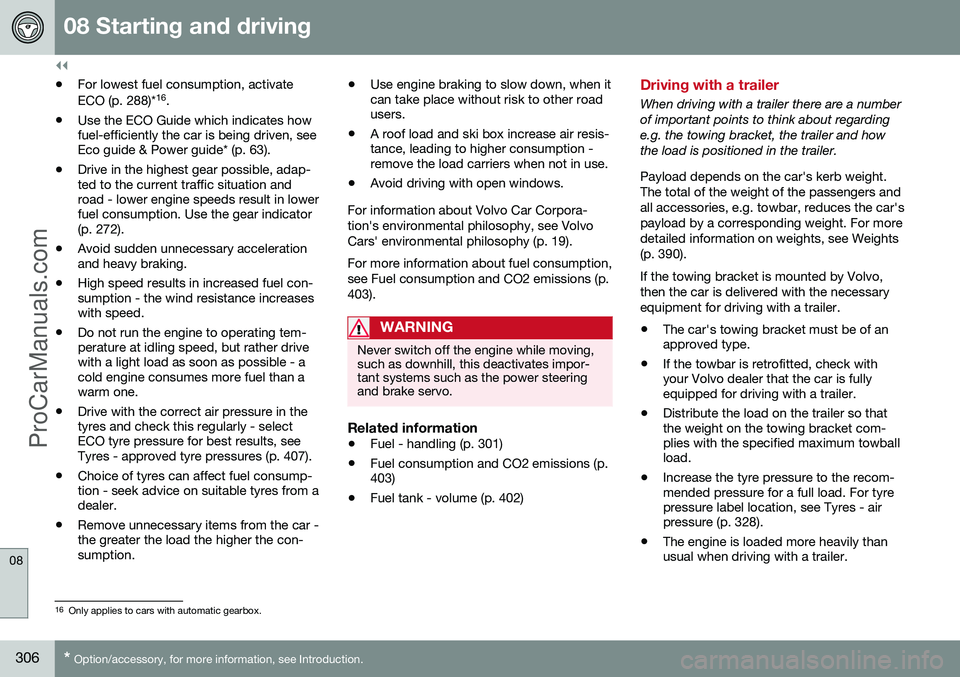
||
08 Starting and driving
08
306* Option/accessory, for more information, see Introduction.
• For lowest fuel consumption, activate ECO (p. 288)* 16
.
• Use the ECO Guide which indicates how fuel-efficiently the car is being driven, seeEco guide & Power guide* (p. 63).
• Drive in the highest gear possible, adap-ted to the current traffic situation androad - lower engine speeds result in lowerfuel consumption. Use the gear indicator(p. 272).
• Avoid sudden unnecessary accelerationand heavy braking.
• High speed results in increased fuel con-sumption - the wind resistance increaseswith speed.
• Do not run the engine to operating tem-perature at idling speed, but rather drivewith a light load as soon as possible - acold engine consumes more fuel than awarm one.
• Drive with the correct air pressure in thetyres and check this regularly - selectECO tyre pressure for best results, seeTyres - approved tyre pressures (p. 407).
• Choice of tyres can affect fuel consump-tion - seek advice on suitable tyres from adealer.
• Remove unnecessary items from the car -the greater the load the higher the con-sumption. •
Use engine braking to slow down, when itcan take place without risk to other roadusers.
• A roof load and ski box increase air resis-tance, leading to higher consumption -remove the load carriers when not in use.
• Avoid driving with open windows.
For information about Volvo Car Corpora- tion's environmental philosophy, see VolvoCars' environmental philosophy (p. 19). For more information about fuel consumption, see Fuel consumption and CO2 emissions (p.403).
WARNING
Never switch off the engine while moving, such as downhill, this deactivates impor-tant systems such as the power steeringand brake servo.
Related information
• Fuel - handling (p. 301)
• Fuel consumption and CO2 emissions (p. 403)
• Fuel tank - volume (p. 402)
Driving with a trailer
When driving with a trailer there are a number of important points to think about regardinge.g. the towing bracket, the trailer and howthe load is positioned in the trailer. Payload depends on the car's kerb weight. The total of the weight of the passengers andall accessories, e.g. towbar, reduces the car'spayload by a corresponding weight. For moredetailed information on weights, see Weights(p. 390). If the towing bracket is mounted by Volvo, then the car is delivered with the necessaryequipment for driving with a trailer. • The car's towing bracket must be of an approved type.
• If the towbar is retrofitted, check withyour Volvo dealer that the car is fullyequipped for driving with a trailer.
• Distribute the load on the trailer so thatthe weight on the towing bracket com-plies with the specified maximum towballload.
• Increase the tyre pressure to the recom-mended pressure for a full load. For tyrepressure label location, see Tyres - airpressure (p. 328).
• The engine is loaded more heavily thanusual when driving with a trailer.
16
Only applies to cars with automatic gearbox.
ProCarManuals.co’
Page 309 of 442
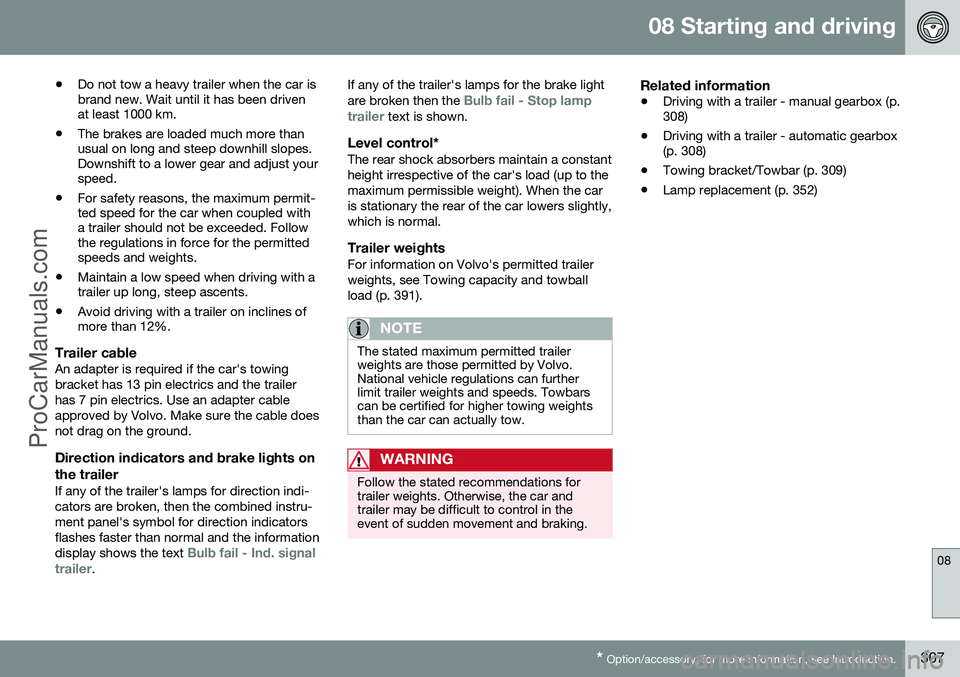
08 Starting and driving
08
* Option/accessory, for more information, see Introduction.307
•
Do not tow a heavy trailer when the car is brand new. Wait until it has been drivenat least 1000 km.
• The brakes are loaded much more thanusual on long and steep downhill slopes.Downshift to a lower gear and adjust yourspeed.
• For safety reasons, the maximum permit-ted speed for the car when coupled witha trailer should not be exceeded. Followthe regulations in force for the permittedspeeds and weights.
• Maintain a low speed when driving with atrailer up long, steep ascents.
• Avoid driving with a trailer on inclines ofmore than 12%.
Trailer cableAn adapter is required if the car's towing bracket has 13 pin electrics and the trailerhas 7 pin electrics. Use an adapter cableapproved by Volvo. Make sure the cable doesnot drag on the ground.
Direction indicators and brake lights on
the trailer
If any of the trailer's lamps for direction indi-cators are broken, then the combined instru-ment panel's symbol for direction indicatorsflashes faster than normal and the information display shows the text
Bulb fail - Ind. signal
trailer. If any of the trailer's lamps for the brake light are broken then the
Bulb fail - Stop lamp
trailer text is shown.
Level control*The rear shock absorbers maintain a constant height irrespective of the car's load (up to themaximum permissible weight). When the caris stationary the rear of the car lowers slightly,which is normal.
Trailer weightsFor information on Volvo's permitted trailerweights, see Towing capacity and towballload (p. 391).
NOTE
The stated maximum permitted trailer weights are those permitted by Volvo.National vehicle regulations can furtherlimit trailer weights and speeds. Towbarscan be certified for higher towing weightsthan the car can actually tow.
WARNING
Follow the stated recommendations for trailer weights. Otherwise, the car andtrailer may be difficult to control in theevent of sudden movement and braking.
Related information
• Driving with a trailer - manual gearbox (p. 308)
• Driving with a trailer - automatic gearbox(p. 308)
• Towing bracket/Towbar (p. 309)
• Lamp replacement (p. 352)
ProCarManuals.co’
Page 310 of 442
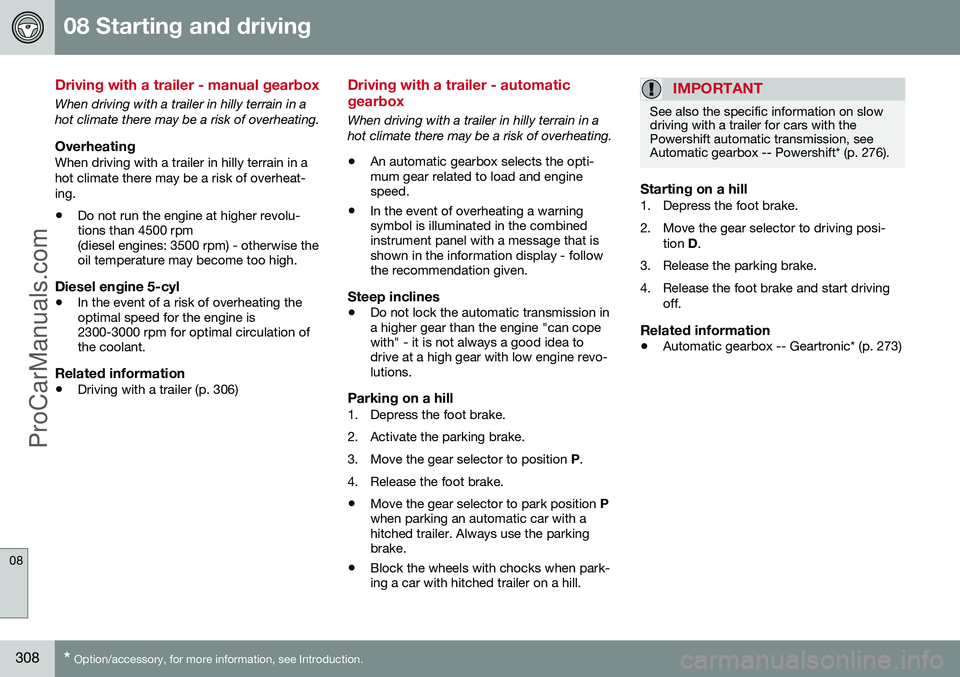
08 Starting and driving
08
308* Option/accessory, for more information, see Introduction.
Driving with a trailer - manual gearbox
When driving with a trailer in hilly terrain in a hot climate there may be a risk of overheating.
OverheatingWhen driving with a trailer in hilly terrain in ahot climate there may be a risk of overheat-ing. • Do not run the engine at higher revolu- tions than 4500 rpm(diesel engines: 3500 rpm) - otherwise theoil temperature may become too high.
Diesel engine 5-cyl
•In the event of a risk of overheating theoptimal speed for the engine is2300-3000 rpm for optimal circulation ofthe coolant.
Related information
•Driving with a trailer (p. 306)
Driving with a trailer - automatic gearbox
When driving with a trailer in hilly terrain in a hot climate there may be a risk of overheating.
• An automatic gearbox selects the opti- mum gear related to load and enginespeed.
• In the event of overheating a warningsymbol is illuminated in the combinedinstrument panel with a message that isshown in the information display - followthe recommendation given.
Steep inclines
•Do not lock the automatic transmission ina higher gear than the engine "can copewith" - it is not always a good idea todrive at a high gear with low engine revo-lutions.
Parking on a hill1. Depress the foot brake.
2. Activate the parking brake.
3. Move the gear selector to position
P.
4. Release the foot brake.
• Move the gear selector to park position
P
when parking an automatic car with a hitched trailer. Always use the parkingbrake.
• Block the wheels with chocks when park-ing a car with hitched trailer on a hill.
IMPORTANT
See also the specific information on slow driving with a trailer for cars with thePowershift automatic transmission, seeAutomatic gearbox -- Powershift* (p. 276).
Starting on a hill1. Depress the foot brake.
2. Move the gear selector to driving posi-
tion D.
3. Release the parking brake.
4. Release the foot brake and start driving off.
Related information
• Automatic gearbox -- Geartronic* (p. 273)
ProCarManuals.co’